EPISODE 620 BARNEY DWAN AND LEGENDS OF IRELAND 1960
alan skeoch
August 2022
NOTE: THIS story about Barney Dwan was triggered by the letter below sent
to me by his grandson, Jamie Dineen.
Hi Alan,
I was sent a link to your website by a relative recently.
A number of your articles (links below) talk about Bunmahon in Co Waterford in Ireland and specifically you mention Barney Dwan who is my grandfather.
Barney has unfortunately just passed away and I am currently visiting Ireland to say goodbye from Whistler in Canada (where I now live). He always told us old stories about working with “Canadian miners” back when he was young. It is so great to see some first hand written accounts of someone who spent some time with him in his youth. He was a bit of a character and he seemed to get a kick out of telling stories that you were never quite sure if they were true or not.
Anyway, on your website you have some incredible photos of Barney in his youth that I have never seen before. So thank you so much for preserving them many years later. I was wondering if you had digital copies of these that you could pass on or any other information relating to his life in your archives. I’m not sure if anyone else from my family has been in touch but it would be great if you had anything to share with us.
Again, thanks for preserving this little piece of history that relates to our family and I am hoping you have time to get in touch.
Best wishes,
Jamie Dineen

The ruins of the Knockmahon copper mine…closed and flooded in the 1870’s.
Could it be reopened?
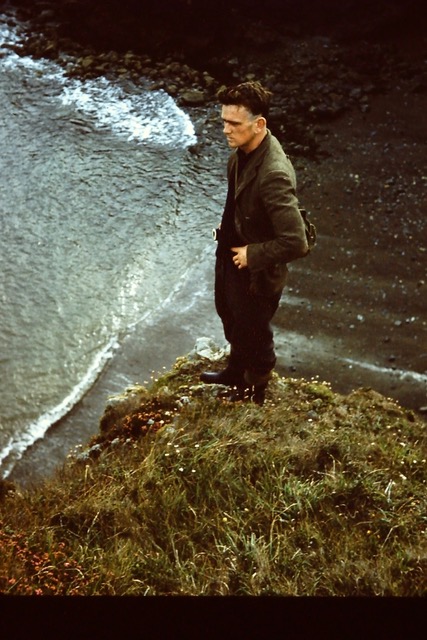
Barney Dwan, my right hand man in that wonderful summer
of 1960. He died in the summer of 2022. He was a great
story teller and an excellent friend. He is standing on the cliff
face that he knew so well.
MEMORIES OF BARNEY DWAN, IRELAND, 1960
THIS MAY TURN OUT TO BE A LONG STORY
BACKGROUND BEFORE BARNEY DWAN ENTERED THE STORY
When I was young, a high school student, I was lucky enough to be hired as a geophysical instrument man.
The job was exciting, demanding, lonely, sometimes dangerous but always enriching. Not financially but
spiritually. I never knew where i was going until almost the day of departure.
On that day I had time to pack a rucksack with all the things I would need for several months.
No suitcase of luggage. Just a Canadian army back pack.
DATELINE: MAY15, 1960
“Alan, forget about Arizona….sudden change…you are going to Ireland.”
“My snake bite training…sucking blood from snake bitten flesh…is now useless.”
“No snakes in Ireland. Should be smooth sailing, Alan, as long as you know
how to set up and run the Turam.”
The Turam is a rather complicated Swedish instrument that is able to find mineral formations
beneath the ground… i.e. without excavating. Here is a simplified description First thing to do is to lay
out single sheathed copper wire ‘base line’ about a mile or more long and
grounded at both ends. Then attach a motor generator to this base line which when running will create a electro=magnetic
field. If there is mineralization then there will be an anomaly,,,something odd, peculiar… in the readings picked up by receiver coils
… two long cylinders of copper coiled wire kept st 100 foot separation. These blips were called
are unusual intrusions in background readings. Rather miraculous machine invented by Swedish engineers.
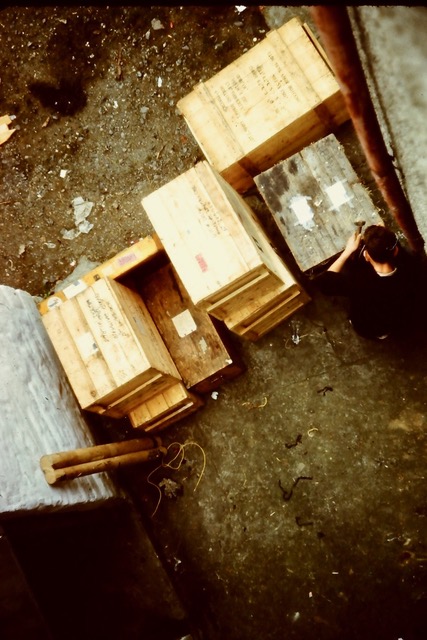
Above is our Turam equipment all crated. The picture will give readers some
idea of the complicated equipment involved
HOW DID I BECOME RESPONSIBLE FOR THIS IRISH INVESTIGATION?
LUCK! Napoleon Bonaparte was once asked how he decided promotions in his army: :Give me the lucky soldiers.” was his reply.
He made instant promotions after battles. I felt like one of those lucky ones.
In the summer of 1959,I was sent to western Alaska with a Canadian seven man survey
crew, Three of us were students at the University of Toronto and the others were professionals
in mining exploration. That summer I initially felt like a square peg in a round hole. Then My partner,
Bill Morrison taught me how to operate the Turam. So there were four field men working the
Alaskan tundra that summer.
The following summer of 1960 I was the only employee of Hunting Exporaton who knew
the Turam system. I was the lucky one. All the others had gone their separate ways.
“ALAN, you will be responsible
for this Irish job? Can you remember the Turam system.”, said Dr. Norman Paterson
“Yes!” I was not as sure as I sounded. This was a big deal. Suddenly I was no longer
the square peg in a round hole. I was epectred to be there right round peg for the
round hole. The Turam. To indicate a lack of confidence would risk losing the job.
If Dr. Paterson was willing to give me sole responsibility for the Irish survey then he
must think I could do it.
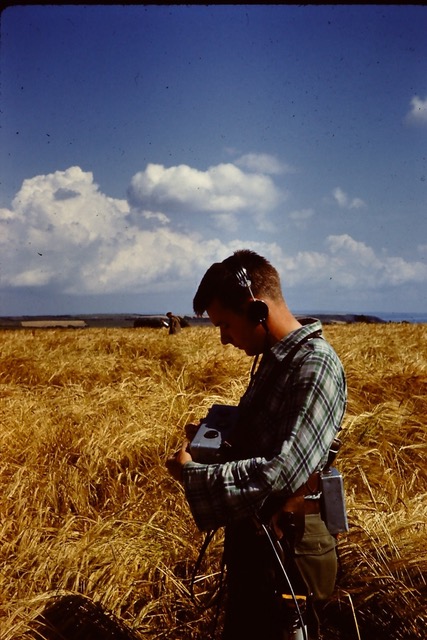
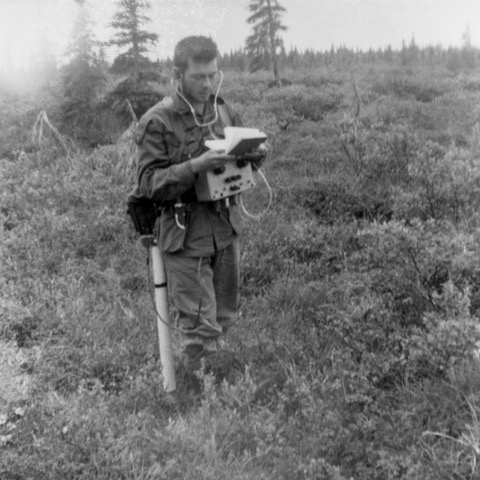
Two pictures of Turam in operation in 1960. One in Ireland as we tramped through a field of ripe wheat much to the anger
of the local Irish farmer who sought payment. Bulls, hogs and ticks were problems The second picture is the same Turam in the wilds of the Alaskan
perma frost scrubland in 1959 where blood seeking flies by the billions sought flesh wherever exposed and Kodiak bears feasted on
dead and living salmon in sunken river valleys. Two places, Ireland and Alaska, same machine…different problems.
EXPECTATIONS
SO I arrived in Ireland alone. One man cannot operate a Turam. The system needs
a minimum of two. Often more than two. Do not get an inflated opinion of my role.
My job ws to get data. Dr John Stam arrived later in the summer His job was the
really important job of interpreting the data. And John Hogan, a geologist was sent
by our client just to keep an eye on what we were doing. Lots of pressure on me, a 22
year old student of history and philosophy at the University of Toronto. Like being in
a goldfish bowl.
Afteer 13 days in Dublin, our crates arrived. Those 13 days were long days.
The tedium was broken, however, by one night at a Dublin movie house watching “The Quiet Man”,
a film that romanitcized Ireland featuring John Wayne and Maureen O’Hara. The movie was
not full of hatred although filmed in the “Time of the Trouble” when Irish Republicans were killing
and being killed by English Black and Tan constabulary. Not a dark film at all. It was full of
joy and minimized the violence. Exaggerated the positive. I loved the film even though I did
not expect my real experience in Ireland would be nearly as pleasant.
Well, as things turned out, I was dead wrong.
ENTER BARNEY DWAN
“Could Southern Ireland be anything like that movie?”
This is where Barney Dwan entered the picture. He was our first
employee. I think he just asked if we needed help the daY I arrived in Bunmahon.
He was hired on the spot. Paid a pound a day… seven pounds
a week….cash. That was the going pay in Ireland in 1960.
My own salary was not much more…$400 per month which amounted to $5 a day.
10 pounds in 1960 is worth 271.86 pounds in 2021 terms. Inflation.
Barney seemed about my age, 22 years old. He had a permanent grin it seemed
even at the beginning when I could not understand his dialect. First mistake. I thought his name
was Bandy much to the amusement of our growing number of employees. I think we
hired about ten men all told. Same pay for all. They all seemed to laugh every time
i asked Bandy (Barney) a question. Eventually I figured out why. Barney was amused
as well and accepted Bandy rather than Barney. Nice chap for sure and very
smart. Figured out what I needed when i needed help. I may have been the boss
but Barney was the manager. That sounds a little officious. Not so. I tried to keep
everyone happy as long as they turned up for work each day. Barney made suggestions
casually. I never realized how important Barney was to our survey until midway though
the job. He had that very Irish way of making suggestions often using stories that
may or may have been true. Such as finding the feet of a nun…feet in her shoes
but nothing else. Hogs had got her crossing a farm field. Hogs rarely kill but they
can consume meat fast when given the chance.
Barney was a big help on our line surveys. I was strapped in. Copper coil hanging from
belt, console, earphones, batter pack on my back, hooked by electric short to man
with front coil. Difficult to move evilly especially in Ireland where the farm fields are
small and line with Gorse hedge. Gorse? Imagine a death by a thousand cuts.
Gorse may well be beautiful when in bloom..thousands of yellow flowers shielded by
thongs …thousands of thorns.
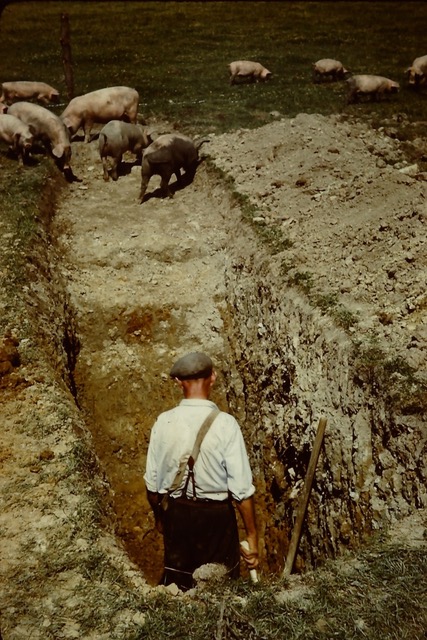
Free range pigs were very curious animals. They investigated our work
regularly as above…which gave Barney an opportunity to tell as story.
“Master Skeoch, story is told about a nun who tried to cut across a farm field.
All that was ever found were her shoes with her feet in them.”
“what happened?”
“No one really knows. Likely the pigs got her. She could not run fast
with those long black clothes.”
’Terrible death. “
“Boars can be violent…hungry..tough.”
“Scary”
“Reason I tell the story is that you are like the nun. You can’t
run with all that gear strapped to you. Boars could get you.”
“Really?”

Crossing a thin bridge over the Mahon River was tricky. I believe that is John Fleming
on the right. He was in charge of our linecutting crew and I think our oldest employee,
A grandfather and very dignified community leader. In the centre is Barney Dwan to
whom this episode is dedicated. My right arm man and the key to my acceptance
as a member of the Bunmahon mining adventure. The man on the right whose name
escapes me was part of excavating crew and I believe he returned to Ireland after
working abroad. It must have been difficult for our older employees to be bossed
by a young 22 year old Canadian. I never felt resentment.
Barney seemed to have endless stories all of which were based in facts even
if bloated to make the story better. A joy to work with.
Perhaps Barney told this Nun story, whether true or false, as Barney’s way of
alerting me to the danger that could be found in those tiny Irish fields.
A charging bull was no problem normally. Fleet footed escape or totally avoiding the field enclosed by
the bull. I could not do that. The Turam harness made running impossible. And our survey had to be done in straight lines
in order to form a grid to map out any anomaly.
“Master Skeoch, you need someone to lift you over the fences or to break a path through
the Gorse. Someone to keep a sharp eye on bulls and boars.”
“Barney, why do all the bulls have rings in their noses.”
“Control mechanism, Master Skeoch, imagine you had a ring in your nose
and someone twisted it. Make you want to do what the twister wanted, would it not?’
“I had a high school teacher, Roberta Charlesworth, who lifted me up vertically by the
ear…like twisting an iron ring in a bull’s nose. “
“What did you do wrong?”
“Seemed I served a detention watching the girls play volleyball in he girls gymnastics
rather than the detention room. Nicer place….but Charlesworth did not think the way i did.”
Now just how dangerous are hogs running loose in a farm field? Do they kill and eat people
regularly. Is the Nun story believable? Such a maladventure is extremely rare. Likely Barney was exaggerating
but I am not sure. There is a list of dangerous creatures that kill humans. The number
one killer is the mosquito (malaria), the number two killer of humans is humans. We kill each
other at a rate of 400,000 each year. Bulls and hogs do not even merit a rating in the list of
killers. Lions, Hippos, Crocodiles, snakes…all are killers big time.
“ Barney, That prickly Gorse is more dangerous than any boar or bull. You have seen me fall just trying to
through the stuff. Gorse surrounds every field. Loaded with needles. Every field is fenced with a million
needles. Capable of drawing blood…lots of blood.”
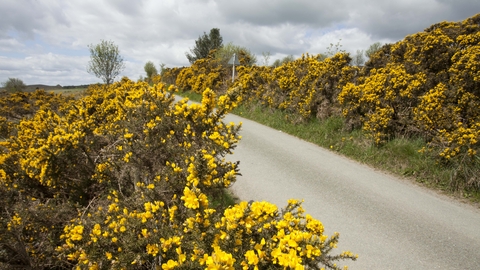
Gorse looks charming from a distance when in bloom.
The charm disappears when challenged with the task of
penetrating the gorse. Surveying grids must have straight lines…
no way of avoiding those gorse needles which can tear both clothing
and flesh.
Our lineutting crew preceded us by setting up a grid which means they penetrated
the gorse before Barney and I. They smashed holes for us to crawl through.
Farmers did not want big holes in their Gorse fences so Barney often had to help me through
the gorse. I fell sometimes
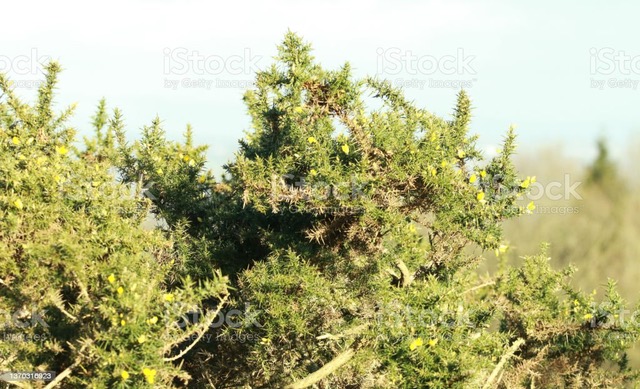
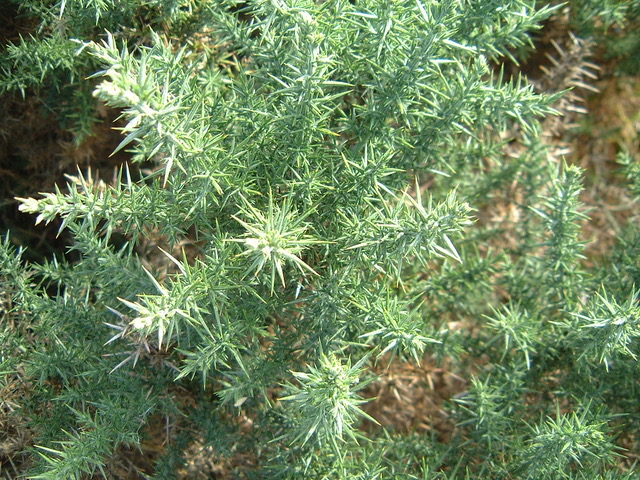
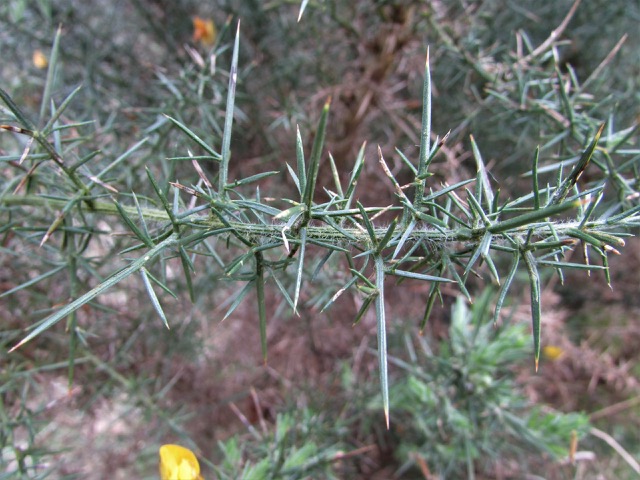
“Master Skeoch , you need help getting through the Gorse.”
“ I agree. The trouble is that my company boss will wonder why I need help in
Ireland when I never needed help in Alaska where Kodiak bears were common. I imagine the gorse problem seemed funny
back in Canada..”
Were bulls and hogs really a danger? In the great scheme of things bulls and hogs were not a dangerous as mosquitoes
snakes and crocodiles. The trouble with bulls is that they were unpredictable. Dairy bulls in particular. They might seem
placid then take offence suddenly. Normally a charging bull could be avoided by jumping a fence. Not so easy in Ireland
where many farmers used gorse hedges as fencing often with a stone wall core.
Were hogs really a danger? Wild boars..yes. But we never encountered a wild boar. Domesticated pigs, however, were
common. Very curious animals. Intelligent. When we dug trenches deep down to bed rock to check our an
anomaly often the trench was ringed with pigs who basically wanted to see what was happening. They were big
but I do not remember a problem. My harness made me immobile no matter what. Barney’s precaution was a
good idea.

Why DOES this bull have a ring in its nose? Surely not for a brave person to grab and twist to control
the bull? Not at all…but the ring hurts if twisted, therefore the bull can be led to the cow or the prize ring.
One ting was certain. I would never be able to grab the ring if a bull denied to attack.
Never feared bulls or boars once we had a man to keep them from charging.
The biggest threat came from one tiny, almost invisible, insect…
MY BIGGEST WORRY WAS TICK BITES
NEXT EPISODE….STORIES IN MEMORY OF BARNEY DWAN
